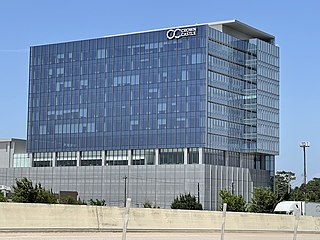Telecommunications in the Philippines are well-developed due to the presence of modern infrastructure facilities. The industry was deregulated in 1995 when President Fidel Ramos signed Republic Act No. 7925. This law opened the sector to more private players and improved the provision of telecom services are better and fairer rates, leading to the creation of many telecommunication service providers for mobile, fixed-line, Internet and other services.
A personal communications service (PCS) is set of communications capabilities that provide a combination of terminal mobility, personal mobility, and service profile management. This class of services comprises several types of wireless voice or wireless data communications systems, typically incorporating digital technology, providing services similar to advanced cellular mobile or paging services. In addition, PCS can also be used to provide other wireless communications services, including services that allow people to place and receive communications while away from their home or office, as well as wireless communications to homes, office buildings and other fixed locations. Described in more commercial terms, PCS is a generation of wireless cellular-phone technology, that combines a range of features and services surpassing those available in analogue- and first-generation (2G) digital-cellular phone systems, providing a user with an all-in-one wireless phone, paging, messaging, and data service.
The liberalization of Bangladesh's telecommunications sector began with small steps in 1989 with the issuance of a license to a private operator for the provision of inter alia cellular mobile services to compete with Bangladesh Telegraph and Telephone Board (BTTB), the previous monopoly provider of telecommunications services within Bangladesh. Significant changes in the number of fixed and mobile services deployed in Bangladesh occurred in the late 1990s and the number of services in operation has subsequently grown exponentially in the past five years.

A cell site, cell phone tower, cell base tower, or cellular base station is a cellular-enabled mobile device site where antennas and electronic communications equipment are placed to create a cell, or adjacent cells, in a cellular network. The raised structure typically supports antenna and one or more sets of transmitter/receivers transceivers, digital signal processors, control electronics, a GPS receiver for timing, primary and backup electrical power sources, and sheltering.

Crown Castle Inc. is a real estate investment trust and provider of shared communications infrastructure in the United States headquartered in Houston, Texas. Operating with 100 offices worldwide, its network includes over 40,000 cell towers and approximately 85,000 route miles of fiber supporting small cells and fiber systems.
In finance, a buyout is an investment transaction by which the ownership equity of a company, or a majority share of the capital stock of the company is acquired. The acquiror thereby "buys out" the present equity holders of the target company. A buyout will often include the purchasing of the target company's outstanding debt, which is referred to as "assumed debt" by the purchaser.

Globe Telecom, Inc., commonly shortened as Globe, is a major provider of telecommunications services in the Philippines. The company operates the largest mobile network in the Philippines and one of the largest fixed-line and broadband networks. As of November 2023, Globe has 54.7 million subscribers, making it the second largest network in terms of subscriber base.
Nepal Doorsanchar Company Ltd., popularly known as Nepal Telecom or NTC, is a state-owned telecommunications service provider in Nepal with 91.49% of the government share. The company was a monopoly until 2003, when the first private sector operator, United Telecom Limited (UTL), started providing basic telephony services. The central office of Nepal Telecom is located at Bhadrakali Plaza, Kathmandu. It has branches, exchanges and other offices in 184 locations within the country.
Unicel was a brand of mobile phone service from Rural Cellular Corporation. Service was provided in northern Minnesota, northern New England, Mississippi, Alabama, eastern Washington and Oregon, and adjacent areas. The company was headquartered in Alexandria, Minnesota. Until 2005, RCC also operated 850 MHz cellular service under the brand name Cellular 2000. On January 25, 2009 Verizon Wireless officially took over all operations of Unicel.
Mauritius Telecom Ltd is a provider of ICT services for both residential customers and businesses in Mauritius, including fixed, mobile, internet, TV, mobile money and ICT services.

Due to economy of scale property of telecommunication industry, sharing of telecom infrastructure among telecom service providers is becoming the requirement and process of business in the telecom industry where competitors are becoming partners in order to lower their increasing investments. The degree and method of infrastructure sharing can vary in each country depending on regulatory and competitive climate.

Palestine Telecommunications (Paltel) Company, listed in the Palestine Exchange (PEX) as PALTEL, is a telecommunications holding company consisting of Palestine Telecommunications (Paltel), Palestine Cellular Communications Ltd. (Jawwal), internet provide Hadara, Reach call center, and Palmedia broadcast media.

Global Tower Partners (GTP), owned by American Tower Corporation and previously based in Boca Raton, Florida, was the largest privately owned telecommunication tower operator in the U.S. and the fourth largest independent operator in this sector. GTP owned, managed, or held master leases for more than 16,000 wireless sites and over 40,000 miles of railroad rights of way throughout the U.S. GTP leased space on towers and rooftops to leading wireless communications providers including AT&T Wireless, Verizon Wireless, Sprint, T-Mobile, US Cellular, Metro PCS, and Leap Wireless. GTP was founded in 2002 and began operations in October 2003. Marc Ganzi, the company's Chief Executive Officer, was the sole founder.

Monaco Telecom is the primary telecommunications provider in the Principality of Monaco. Established in 1997, the company was formed following the government of Monaco's decision to privatize the previously state-owned Office Monégasque des Téléphones. Monaco Telecom provides various services including internet access and mobile phone services. It is a key entity in facilitating communication within Monaco and connecting the principality to global telecommunications networks. Additionally, the company operates a retail store which functions as a point of service and customer interaction.

SBA Communications Corporation is a real estate investment trust which owns and operates wireless infrastructure in the United States, Canada, Central America, South America, and South Africa.
The Wireless Infrastructure Association (WIA), formerly known as PCIA, is an American trade association for wireless providers and companies that build cell phone towers, rooftop wireless sites, and other facilities that transmit wireless communication signals. The Washington Post described the industry as "the people who build all those cell towers so you can actually make those calls, download that data." These technologies are collectively referred to as "wireless telecommunications infrastructure."

"Mobile tower fraud" may be defined as a type of mass marketing fraud with advance fee fraud characteristics, where the central scheme is the installation of a mobile tower in the victim's property. The victims are lured by the promise of huge rental income. Mobile tower fraudsters are targeting individuals of all ages and demographics. With the telecommunication infrastructure booming in India to meet the socioeconomic requirements of the country, mass marketing fraudsters have seen a criminal opportunity in it.
Cellnex Telecom is a Spanish wireless telecommunications infrastructure and services company with up to 135,000 sites -including forecast roll-outs up to 2030- throughout Europe. Its activity is divided into four main areas: services for telecommunications infrastructures; audiovisual broadcasting networks; security and emergency network services; and solutions for the intelligent management of urban infrastructures and services.

Now Telecom Company, Inc. is a telecommunications firm based in the Philippines. The company provides broadband and fiber-optic communication services to upper-class residential and commercial areas in Metro Manila under the Now Fiber Air brand. The firm, along with Now Corporation and News and Entertainment Network Corporation (NEWSNET), formed the unified Now Network service.
The Service-Telecom Group of Companies is an independent wireless telecommunication infrastructure operator that constructs and leases antenna-mast structures (AMS) to place telecom equipment.









